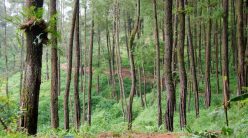web.uct.ac.za
J.A. Harrison
ADU, UCT, Rondebosch, 7701
While scanning old issues of Ostrich, I was struck by the photograph on the next page which shows a large colony of South African Cliff Swallow Hirundo spilodera nests on the walls of a building. I had never come across this type of nest site in this species before, and the fact that it was a man-made structure, but different to the culverts and bridges normally used, pricked my interest. The structure is an old mill building on the farm Wheatlands in the Graaff- Reinet district and it is reported to have been colonized continuously from 1896 to the year of writing, 1940 (Taylor 1942). Further investigation led me to an article by none other than Austin Roberts (1939), who gave the following account of cliff swallows nesting on buildings:
‘By far the commonest of the Swallows in the Union is the Cliff Swallow, which formerly nested in large communities under overhanging rocks or earth banks on rivers, but had found the eaves of buildings, bridges, railway water tanks and the like so much suited to it that it has increased enormously in numbers in recent years. In the early ‘nineties (That’s the 1890s! – Ed.) it nested in great numbers under the eaves of the ‘Gereformeerde’ church at Potchefstroom and also on some farm houses in the neighbourhood. More recently a great controversy raged in the local newspaper, owing to the local fire brigade having been used to turn the hoses on the nests to wash them away! The church community at Strydenburg, C.P., solved the problem of keeping away these Swallows from building under the eaves of the church and causing much trouble by the mess they made, by erecting fine wirenetting wherever they were likely to build their nests. Such favoured nesting sites are not confined to churches and large public buildings, but also private residences in towns in many cases – if they are tolerated.’
Other accounts of SA Cliff Swallows using occupied buildings were found in Godfrey (1943), Winterbottom (1962) and Rowan (1963), but these, plus the two accounts cited above, all referred to old records from years spanning 1879 to 1940. As in the quote above, these also refer to vigorous efforts made to deter the birds from nesting on buildings, because of the mess and the parasites that accompanied them. They generally give an impression of the birds being resilient and difficult to dissuade.
My curiosity now thoroughly aroused, I canvassed the wealth of experience and first-hand knowledge available through the internet interest group, SABIRDNET (sabirdnet@unp.ac.za). I asked for information on any South African Cliff Swallow nest sites which are not situated on bridges or culverts. These are the responses received:
Mike Pope (Mpope@Maven.co.za): I live in Midrand where there are three separate Cliff Swallow colonies. Two are under large stormwater drains which are under two really busy roads, and the last is under the eaves of an abandoned cattle kraal in an open grassland.
Dr Pete Irons (pirons@op1.up.ac.za): In 1990 near Ramathlabama on the South African-Botswana border, there was a small colony nesting in an old farm building with a flat roof. The number of birds involved was not more than about 20-30. It was a flat area in bushveld habitat, without much suitable topography or structures for nest sites in the area.
Dr Hamish Campbell (finfoot@icon.co.za): In September 1987, Johann Knobel took me for a weekend to Barberspan. Here we saw hundreds of SA Cliff Swallows roosting in a deserted and disintegrating corrugated iron hangar which, I presume, had served an ancient airstrip there.
Stephan Terblanche (sterblanche@mailhub.cpro.co.za): I recall seeing Cliff Swallow nests at Barberspan, on the north-western side of the pan, in about 1995. They were under the roof of a large corrugated-iron barn, which had open sides.
David Allan (DavidA@prcsu.durban.gov.za): I saw SA Cliff Swallows breeding under overhangs on Ecca sandstone cliffs at Bald Ibis breeding colonies in Mpumalanga Province years ago. I have one record of this for the Bald Ibis colony on the farm Buhrmansklipkrans (2630CAC); on 30/9/1982 I recorded c. 15 birds at nests, and on 29/10/1982 hundreds of birds at active nests. I also recorded a colony at Barberspan (2625DAA) on 3/2/1983 when there were c. 40 active nests under an isolated concrete structure in the middle of the pan.
Shaun Peard (desel@iafrica.com): I recently saw a colony of SA Cliff Swallows nesting under the eaves of an old dressed stone building about 20ÿkm south of Dordrecht on the Queenstown-Dordrecht road. There must have been in excess of 70 nests. The building appeared to be still used as a trading store and was about 30ÿm off the edge of this busy road.
Paul Martin (apmartin@global.co.za): The colony in Dordrecht, reported by Shaun Peard, has been in existence for many years and is the most unusual nest site I have seen. They nest rather like House Martins at this venue. Bob Cullen (rc36@mweb.co.za): On 2 May 1993, during a visit to Suikerbosrand Nature Reserve near Heidelberg, Gauteng, I noted that SA Cliff Swallows appeared to be nesting in the main Administration Block there. This is not certain because, although they were disappearing under the eaves, I couldn’t actually see the nests from the road.
Dr Alan Kemp (kemp@tm.up.ac.za) and Andrew Tucker (S9604547@op1.up.ac.za): SA Cliff Swallows nest under the main gate to the CSIR, Pretoria, which is rather bridge-like. At least during 1970-74, they nested under the eaves of a silo on the University of Pretoria Proefplaas, just across the road from the CSIR (and may still do); the latter colony may have sprung from the CSIR one. Otherwise I know only bridges (e.g. Witbank N4, a huge core colony for many years since construction of the N4, which has spread to several neighbouring bridges only this decade).
Dieter Oschadleus (dieter@adu.uct.ac.za): Cliff Swallows bred on the buildings of the CSIR, Pretoria, for many years. Burgerjon (1964) conducted a breeding study on these colonies from 1958 to 1961. When I worked at the CSIR as a student in the December holidays of 1985 to 1988, I recall seeing the swallows breeding on the buildings. To prevent the swallows from breeding, netting was being put in front of the entire Nuclear Physics building of several floors height!
I spent the next year in the army and returned to work at the CSIR in 1990. I’m not sure if the swallows were still breeding on the buildings at that time. From January 1995 to September 1997 I kept a weekly species list of the waterbirds at the CSIR. Cliff Swallows were seen drinking water from the main dam (Oschadleus 1995), but I did not record breeding activity. From my (untrustworthy?) memory the swallows were only breeding in a fair-sized colony on the A-frame entrance gate, with possibly an occasional attempt on some of the CSIR buildings. From March 1996 to September 1997 I kept a monthly species list of the all CSIR birds. Cliff Swallows were present in August 1996 to February 1997 and in September 1997. The swallows definitely bred on the A-frame gate in the summers of 1996/97 and 1997/98.
The netting (possibly applied for a few years in the late 1980s) seems to have resulted in the swallows moving their colony to the A-frame gate. This causes a mess of droppings, feathers and occasional dead chicks on the road leading into the CSIR. The site maintenance team considered destroying the site but staff resisted the idea. Now the nests are cleared away after breeding is completed and the birds have migrated. In contrast, Little Swifts Apus affinis have bred on the CSIR buildings (Nuclear Physics and many others), probably every year and certainly the last five years. Although they would have been excluded from some nesting sites by the netting, they can breed on more inaccessible sites. They also seem to breed in smaller colonies scattered throughout the CSIR, making any attempts to eradicate them impractical.
Martin Kerr (martin.kerr@eskom.co.za): Alan Kemp mentioned the colonies of swallow nests under the bridges across the Pretoria-Witbank highway N4. When we first travelled that road back in 1978/79, I noticed that all the nests were on the exit sides of both lanes, on the opposite side to the oncoming traffic. More recently the nests have spread to both entry and exit sides of the bridges and I wondered what caused the change. Other puzzling facts are that not all the bridges have nests on them, and there are far fewer bridges across the Witbank-Johannesburg highway that have nests on them. The design of the bridges could be a factor.
Dr Pieter van Eeden (PieterVE@erlab.erwat.co.za): I am the pollution ecologist for East Rand Water Care Co. and we have a wastewater treatment plant (WWTP) in Olifantsfontein, between Kempton Park and Midrand. A relatively new second-phase treatment plant was not put into use owing to technical problems, but was kept filled with water to prevent cracks from forming. Concrete bridges cross over and around the sides of the aeration chambers to get to the aerators. Under these walkways, I saw many active nests with SA Cliff Swallows flying to and from them.
Derek Solomon (osi@internet.co.zw): I know of no records of SA Cliff Swallows in the Matobo Hills, near Bulawayo in Zimbabwe. (The Matobo Hills could be considered a suitable natural site for cliff swallows to nest at because of the extensive granite cliffs. – Ed.) They were recorded breeding in a culvert over a road outside Bulawayo many years ago, then disappeared. The records in ASAB2 are for a small colony that appeared out of the blue during that period – just outside the village of Headlands, and I ringed some of these birds. Unfortunately the site is very exposed and the nests were vandalized on several occasions. As far as I know no birds returned to this site last year. These are the only known breeding records for this species in Zimbabwe.
Burke Korol burke.korol@sk.sympatico.ca: The cliff swallows Petrochelidon pyrrhonata here in Canada often use buildings and bridges for nesting, but they still use rock faces when they are available. Just last year I found a couple of colonies in British Columbia, with 25 and 75 nests each. (Prior to being placed in the genus Hirundo, the SA Cliff Swallow was considered to belong to the genus Petrochelidon. – Ed.) Add to these the findings of Dr Roy Earlé who did an intensive study of the species in the Free State in the 1980s. He found only a few ‘natural’ breeding sites, these all being in man-made quarries. All the colonies in the Free State were ‘distant from human habitation and no colonies were located in barns or any other structures occupied by humans’ (Earlé 1985).
From all of this I think one can draw a number of conclusions:
SA Cliff Swallows have been using man-made structures as nest sites for at least 120 years, possibly considerably longer.
The first 60 years of this historical period appear to have been characterized by the birds’ use of a wide range of man-made structures, including bridges, water towers, churches, brick-and-stone residences, and African huts (Godfrey 1943). In most cases this met with vigorous attempts to discourage colonization of buildings and to destroy existing colonies.
Since this early period, there has clearly been a marked shift in, or perhaps only a narrowing of, the choice of man-made sites, so that now the overwhelming majority of nest sites are located under bridges and culverts, or on other concrete structures which resemble these. Although many of these sites are over water, the presence of water does not appear to be a determining factor (Earlé 1985).
Some breeding colonies still use occupied buildings, natural and semi- natural sites, but this is rare.
The breeding range of the SA Cliff Swallow is largely restricted to the grassland biome and the adjacent grassy eastern parts of the Nama Karoo in South Africa. It is interesting to note that its abundance is not nearly as great in highland sour grasslands as in lowland sweet grasslands (ASAB2). It is reasonable to assume that this is approximately representative of the original distribution before human colonization, and that breeding sites would therefore have been restricted to sparsely scattered rocky outcrops and hills, and to suitable earthen banks along watercourses.
In various accounts it is stated that the range and abundance of the SA Cliff Swallow have undergone a number of significant fluctuations, with the implication that expansions may be causally linked to adaptation to new breeding sites, and contractions to persecution at those sites (e.g. Roberts 1939; Godfrey 1943; Rowan 1963). Given that these swallows forage over open, grassy habitats near to their breeding colonies (Roberts; ASAB2), and that they are highly social, it is clear that breeding sites are an important factor in distribution. The development of a modern road network is a relatively recent, post-war phenomenon, seeming to correlate fairly well with the end of the period during which buildings were used on a large scale by the swallows. The numerous new bridges and culverts must have provided a superabundance of suitable and relatively safe nesting sites – good alternatives to either natural sites or buildings. The range of the bird corresponds well with areas of intense development where such roads were built first; as modern roads extended into relatively remote rural areas, the species was given the opportunity to expand its range (e.g. Brooke 1959; Winterbottom 1959).
I find it remarkable that virtually the entire population of a species can make not one but two radical changes in its breeding behaviour in the space of a century or so. The plasticity of bird behaviour is a fascinating field of enquiry which forces one to consider the issue of ‘culture’ in wild populations. How are changes in behaviour initiated? How are new ideas transmitted? What determines whether a particular behaviour spreads and becomes entrenched, or remains unstable and changeable? How are choices between old and new ways made? Surely the SA Cliff Swallow must offer unusually good opportunities to investigate some of these questions.
References
Burgerjon, J.J. 1964. Some census notes on a colony of South African Cliff Swallows Petrochelidon spilodera (Sundevall). Ostrich 35: 77-85.
Brooke, R.K. 1959. Avian highlights of a journey across southern Africa. Ostrich 30: 82-83.
Earlé, R.A. 1985. The biology of the South African Cliff Swallow Hirundo spilodera. PhD thesis, Rhodes University.
Earlé, R.A. 1986. The breeding biology of the South African Cliff Swallow. Ostrich 57: 138-156.
Godfrey, R. 1943. The South African Cliff Swallow. Ostrich 14: 219-226.
Oschadleus, H.D. 1995. Swift and swallow drinking patterns. Laniarius 56: 26. [Also reprinted in Birding in Southern Africa 47(2): 49.] Roberts, A. 1939. Swifts and other birds nesting in buildings. Ostrich 10: 85-99.
Rowan, M.K. 1963. Range of the Cliff Swallow. Ostrich 34: 181-182.
Taylor, J.S. 1942. Notes on the martins, swallows and swifts: Graaff-Reinet. Ostrich 13: 148-156.
Winterbottom, J.M. 1959. Range of the cliff swallow. Ostrich 30: 87.
Winterbottom, J.M. 1962. Some manuscript notes of S.F. Townsend for the period 1878-1925. Ostrich 33:66-71.





